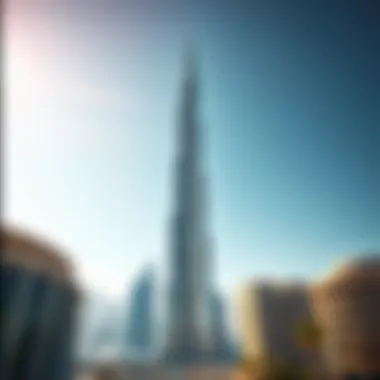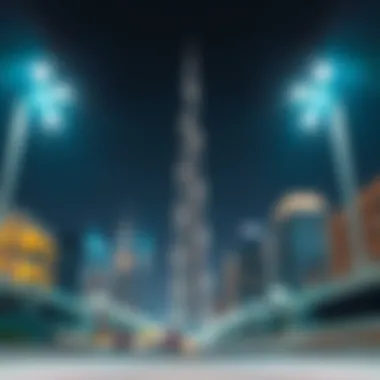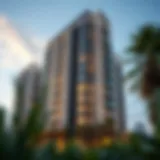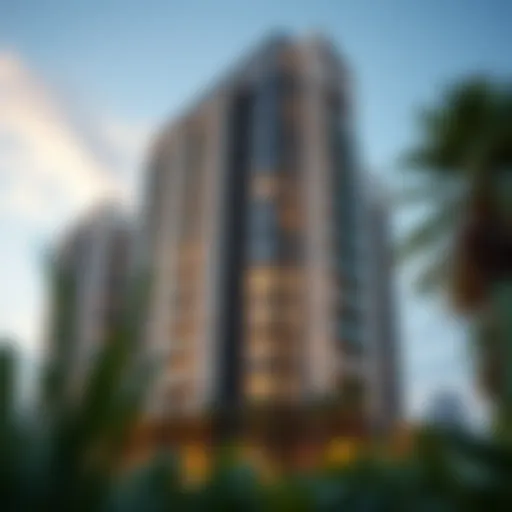Exploring the Height of Burj Khalifa and Its Impact


Intro
The Burj Khalifa stands tall as a symbol of architectural prowess and ambition, catching the eye of many around the globe. With a staggering height of 828 meters, it not only claims the title of the tallest building but also represents the zenith of engineering and design in modern architecture. This article sets out to explore the intricacies surrounding the Burj Khalifa's height, shedding light on the innovations that went into its construction, its cultural significance to Dubai, and how it stacks up against other architectural giants in the world.
As we embark on this exploration, it is important to understand what makes the Burj Khalifa more than just another skyscraper. From its foundation to the pinnacle that reaches for the skies, each component of this magnificent structure tells a story of dedication and ingenuity.
The concept of height in architecture transcends mere measurements; it encompasses the vision that fuels the desire to reach new heights — both literally and metaphorically. Therefore, we will delve into various factors that contribute to the Burj Khalifa’s noted supremacy, unravel the engineering feats accomplished during its construction, and examine its impact on the cityscape and culture of Dubai.
Given its prominence and the continual discussion about skyscrapers and their role in real estate and urban development, it’s crucial for investors, buyers, agents, developers, and expatriates to grasp not only the architectural facets but also the market trends, cultural impact, and investment opportunities linked with such towering edifices. In doing so, we hope to offer a comprehensive narrative that not only enlightens but also prepares you for the nuances of engaging with properties that have been influence by the legacy of the Burj Khalifa.
Prolusion to Burj Khalifa
When one thinks of tallest structures in the world, the Burj Khalifa surely stands as a premier example. Towering over the skyline of Dubai, this architectural wonder is more than just a feat of engineering; it embodies the ambitions and dreams of a rapidly modernization city. This section sets the stage for understanding the intricate tapestry of historical significance, architectural intent, and cultural relevance tied to the Burj Dubai's most iconic structure.
Historical Context
The inception of the Burj Khalifa can be traced back to the early 2000s, a time when Dubai was seeking to redefine its identity on the global stage. Following the economic boom fueled by oil revenues, the emirate envisioned a project that would showcase its aspirations. Construction commenced in 2004, and by 2010, the skyscraper reached its record-breaking height of 828 meters. The project was not merely about reaching new heights; it was a strategic move to establish Dubai as a hub for tourism and international business.
During its development, Burj Khalifa faced numerous challenges. These ranged from extreme weather conditions to sourcing appropriate materials, as the desire to break records came coupled with significant pressure to perform. Despite these hurdles, the Burj Khalifa was completed ahead of schedule, a testament to the ingenuity of the designers and engineers involved. The building now stands as a historical milestone reflecting Dubai’s vision.
Architectural Vision
The architectural vision behind the Burj Khalifa is both innovative and ambitious. Designed by the renowned firm Skidmore, Owings & Merrill, under the guidance of architect Adrian Smith, the tower is inspired by the desert flower Hymenocallis, which is native to the region. This influence is evident in its Y-shaped floor plan, which not only maximizes views from each unit but also enhances structural stability and efficiency.
Incorporating a blend of modernist and traditional Islamic architecture, the Burj Khalifa showcases a delicate balance of aesthetics and function. The exterior clad in reflective glass and brushed stainless steel not only symbolizes progress but also is designed to withstand the harsh desert climate. Beyond appearance, the design reflects sustainable principles, with a series of stairwells and a strategic wind-resistance framework that supports its towering stature.
Significance to Dubai
The significance of Burj Khalifa to Dubai cannot be overstated. It has transformed the city’s skyline and has become a symbol of national pride. The building attracts millions of visitors every year who come to experience its observation decks, luxurious hotels, and fine dining. In doing so, it has established Dubai as a global tourist destination, driving revenue and creating jobs.
Moreover, Burj Khalifa has sparked a chain reaction in urban development. Following its completion, numerous other skyscrapers and projects have emerged in close proximity, contributing to what is now known as Dubai’s "Skyscraper City." This pivotal landmark has influenced architecture worldwide, serving as a reference for cities looking to increase their vertical presence in an ever-evolving urban landscape.
"The Burj Khalifa stands not just as a structure, but as a beacon of innovation and possibility, encapsulating the spirit of Dubai."
In summary, the Burj Khalifa is much more than a lofty edifice. It embodies the historical aspirations of a nation, reflects innovative architectural ambition, and plays a crucial role in the economic and cultural fabric of Dubai. Understanding these facets enhances our appreciation for this monumental achievement.
Defining the Height of Burj Khalifa
Striking and towering, the Burj Khalifa is more than just a skyline feature; it is a testament to architectural ambition and engineering feats. To truly appreciate its magnificence, it's best to delve into the specific definitions and measurements surrounding its height. Understanding this can provide insights not just into the building itself, but also the broader implications for urban development and architectural pride in Dubai.
Measuring Techniques
The methodology behind how the height of the Burj Khalifa is calculated is meticulous and complex. Unlike standard buildings where height might simply be a vertical measurement from the ground to the roof, the Burj Khalifa's measurement involves multiple factors that add layers of precision.
- Point of Measurement: The height is generally measured from the base level to the tip of the antenna. This includes the spire at the top, distinguishing it from other buildings where height may not include such extensions.
- GPS Technology: In today’s world, modern technology has taken center stage. Sophisticated GPS devices are utilized to ensure accuracy, pinning down the exact coordinates for elevation. This helps to eliminate discrepancies caused by geographical variations.
- Laser Measurement: Employing laser technology allows for precise recordings of structural elements. This method is particularly useful in large-scale projects, providing rapid and accurate distance measurements without needing physical contact.
Effective communication about these techniques not only highlights the engineering prowess behind the Burj Khalifa but also enhances its appeal as an icon.
Official Height
As claimed by its developers, the Burj Khalifa officially stands at an impressive 828 meters, or approximately 2,717 feet. This measurement has sparked considerable attention as it exceeds its nearest competitor, the Shanghai Tower, by more than 200 meters. However,
- The choice to measure to the pinnacle of the antenna rather than just the building itself contributes to its claim of being the tallest structure globally.
- In official records, the Burj Khalifa has been recognized and certified, which garners it a place in world records and ensures its title is well established.
Moreover, the height collectively embodies the aspirations of those who built it, representing a significant milestone in construction and a beacon of the limitless potential in vertical architecture.


Height Controversies
With greatness often comes contention. The Burj Khalifa has not been without its own share of debates regarding its height and what constitutes that stature. Consider these points:
- Comparative Height: Some buildings offer different measurements due to their architectural designs, such as the Abraj Al Bait Clock Tower in Mecca, which claims to be 601 meters tall without considering its antenna.
- Spire vs. Structure: There are differing opinions on whether features like spires should be included in height measurements. While some argue they enhance the aesthetic, others believe they should not count towards the structural height itself.
- Public Perception: The public often misunderstands what height means, leading to debates about visibility from various perspectives. The perception of height can differ greatly depending on location and terrain.
Ultimately, while the Burj Khalifa may stand as the tallest building, the controversies surrounding its height remind us that measurement is as much about standards as it is about scale.
"The Burj Khalifa represents not only the zenith of engineering but also the aspiration to reach new heights, both figuratively and literally."
This exploration into defining the height of the Burj Khalifa not only clarifies its standing but also showcases the nuanced conversations surrounding architectural measurement and perception.
Architectural Features
Exploring the architectural features of Burj Khalifa offers a deep insight into who, and what, Dubai hopes to represent on the global stage. It’s not just a building; it’s a showcase of cutting-edge design and engineering, combining aesthetics with functionality in a way that is both pleasing to the eye and practical in its purpose. Every element of the structure has been meticulously planned and executed, reflecting not just heights achieved but milestones in architectural prowess.
Design Elements
The design of Burj Khalifa is an amalgamation of various influences, merging traditional Islamic architecture with modern techniques. The building's unique shape, which narrows as it ascends, resembles a stalagmite, a nod to the region’s geology. It's no surprise that the famous architect Adrian Smith, who oversaw the project, used geometrical patterns common in Islamic culture. These designelements play a crucial role in creating a visually distinct silhouette against the Dubai skyline.
Moreover, the structure features setbacks—areas where the building's form steps back at various intervals. This was not just for visual appeal; these steps function to reduce wind loads on the building, allowing it to withstand the harsh weather conditions common in the region.
Materials Used
When it comes to materials, Burj Khalifa is nothing short of revolutionary. Over 103,000 square meters of glass were used, creating a reflective facade that glistens like a jewel under the relentless sun. This wasn’t just for show; the glass was specially treated to control heat absorption, keeping the interiors cool while minimizing energy consumption.
Another vital material is the high-strength concrete used in the core of the building. This concrete was formulated to withstand the immense pressures exerted by the height and weight of the structure. The choice of materials reflects a broader commitment to sustainability and efficiency in construction, making Burj Khalifa not only a feat of engineering but also an example of modern environmental consciousness.
Innovative Engineering
The engineering feats behind the Burj Khalifa are nothing short of extraordinary. One of the most notable innovations is the use of a bundled tube system, which provides structural stability while allowing for maximum space efficiency. This system consists of three wings that come together at the core—an ingenious solution that has set a new benchmark in skyscraper engineering.
The foundations of the Burj are also groundbreaking, literally and figuratively. Deep foundation piles were drilled into the ground to ensure stability, allowing it to sit securely even on the shifting sands of Dubai. Engineers had to develop a new method of monitoring the effects of wind on such a tall structure during its design process, ensuring safety and longevity in its operation.
Designing for height introduces complexities not usually faced in typical buildings. Wind tunnel testing was conducted extensively to predict and mitigate any adverse effects. The results were pivotal; they guided adjustments that ultimately determined the structure's ability to withstand storms and other natural forces.
In summary, the architectural features of the Burj Khalifa highlight the seamless synergy between design, materials, and engineering that makes this building a symbol of Dubai’s aspirations. As the world’s tallest structure, it has become a benchmark for future projects striving for similar heights in both literal and metaphorical terms.
Cultural and Economic Impact
The Burj Khalifa is not merely an architectural wonder; its influence stretches far beyond its impressive height. This section will explore how this monumental structure has played a significant role in shaping Dubai's cultural landscape and its economic trajectory. The importance of understanding these impacts is multifaceted, shedding light on the symbiotic relationship between iconic landmarks and the cities they inhabit.
Tourism and Global Recognition
As the tallest building in the world, the Burj Khalifa is a global icon that attracts millions of tourists each year. Its sheer height and striking design draw visitors from every corner of the globe, making it one of the main reasons tourists flock to Dubai.
- Tourist Attraction: The observation decks on the 124th and 148th floors provide breathtaking views, immersing visitors in the beauty of the city and the surrounding desert. This experience is often cited in traveler reviews, highlighting it as a must-see destination.
- Promotional Events: The Burj Khalifa hosts numerous events, especially fireworks displays during New Year's Eve which garners international attention. Such events not only celebrate local culture but also serve as marketing tools, fostering Dubai's reputation as a lavish, modern metropolis.
- Recognition as a Landmark: Numerous international publications and travel guides recognize the Burj Khalifa as a defining image of Dubai, reinforcing its status as a global destination. This recognition boosts tourism and contributes significantly to the city's visibility on the world stage.
"The Burj Khalifa has become more than just a building; it’s a symbol of aspiration and a beacon that draws the world together."
Economic Contributions
The economic ramifications of constructing and maintaining the Burj Khalifa are profound. It serves not only as a commercial hub but also stimulates various sectors within Dubai's economy:
- Job Creation: The construction phase alone created thousands of jobs, from laborers to engineers. In the long run, the ongoing operations of restaurants, hotels, and retail spaces continue to provide employment opportunities.
- Increased Investment: The tower has encouraged both domestic and foreign investment in Dubai's real estate market. High-profile businesses seek to establish their presence in the tower or its vicinity, drawn by the prestige associated with the tallest building in the world.
- City Revenue: The tourist influx contributes to the local economy through hospitality, transportation, and various services. Increased foot traffic around the area means higher sales for nearby businesses, which collectively bolsters the overall economic health of the city.


Cultural Symbolism
Symbolically, the Burj Khalifa stands not just as a structure but as a representation of ambition and the desire for progress. The narratives attached to its existence carry significant cultural weight:
- Representation of Vision: The Burj Khalifa embodies the vision of Dubai as a city that embraces modernization and overcomes natural limitations through engineering marvels. It reflects the aspirations of a nation that has rapidly transformed itself into a global hub.
- Cultural Fusion: The Burj Khalifa serves as a cultural meeting point, blending local tradition with contemporary design. Its architecture is rooted in Islamic motifs while seamlessly incorporating modern materials and techniques, showcasing the fusion of old and new.
- National Pride: For locals, the tower instills a sense of pride. It serves as a testament to their heritage and the relentless pursuit of excellence. The identity of Dubai is, in many ways, tied up with this iconic structure, making it a vital aspect of the city’s cultural fabric.
In summary, the cultural and economic impact of the Burj Khalifa is deep and multifaceted, influencing tourism, economic growth, and local identity. Its significance cannot be overstated; it stands not only as the tallest building but also as a powerful catalyst for change in the fabric of Dubai.
Comparison with Other Skyscrapers
When we look at the towering spire of the Burj Khalifa, it’s hard not to compare it with other celebrated skyscrapers around the globe. This comparison unfolds various layers – from architectural genius and engineering prowess to cultural significance and influence on urban landscapes. Understanding these dimensions helps us appreciate why the Burj Khalifa stands as not just a marvel of human achievement, but also as a benchmark against which other structures are measured.
Height Comparisons
The Burj Khalifa is a giant among its peers, but what does this actually mean?
- Record Heights: Currently, the Burj Khalifa holds the title as the tallest building in the world, with a height of 828 meters. To put things in perspective, the second tallest, Shanghai Tower, reaches only 632 meters.
- Visual Impact: Standing at over 100 meters above its closest competitor, the Burj Khalifa dramatically alters the skyline of Dubai, making it impossible to miss.
- Skyscraper Evolution: Other notable buildings like One World Trade Center and the Petronas Towers might boast their heights, but they don’t reach the dizzying dreams sketched into modern architecture by Burj Khalifa.
While the height alone doesn’t tell the full story, it does set the stage for considering design and innovations.
Architectural Innovations
The Burj Khalifa’s architectural design is a synthesis of multiple innovative factors that influenced other skyscrapers:
- Fluidity and Aesthetics: Designed by Adrian Smith for Skidmore, Owings & Merrill, the building’s aesthetics are far removed from traditional box-like towers. Its geometry is reminiscent of desert flora, which pays homage to its surroundings.
- Vertical City Concept: This structure incorporates multiple uses within one framework, with residential, commercial, and hotel spaces creatively intertwined, setting a precedent in urban planning.
- Wind Protection Systems: Engineers implemented cutting-edge solutions that mitigate wind forces better than conventional designs, making it a case study for future architects globally.
These innovations not only set the Burj Khalifa apart but also establish it as an exemplar for future skyscrapers, prompting other cities to rethink their architectural ambitions.
Cultural Significance of Other Structures
Beyond height and design, other skyscrapers carry their significance in ways that differ from the Burj Khalifa. Consider a few examples:
- Eiffel Tower in France: While not a skyscraper in the modern sense, this structure paved the way for vertical architecture. It symbolizes Parisian culture and creativity.
- Empire State Building in New York: Released in 1931, the Empire State Building reflects America's innovation spirit and remains a noteworthy cultural icon even decades later.
- Willis Tower in Chicago: Known for its skydeck, it signifies Chicago’s architectural identity and contributes to the city’s cultural narrative.
Each of these buildings tells a story. They represent the aspirations and evolutions of the regions they inhabit, drawing parallels between times gone by and the change that the Burj Khalifa signals for the future of architectural ambition.
"The Burj Khalifa does not merely tower over Dubai; it stands as a monument to human ingenuity—in a city transformed by ambition."
In summary, while the Burj Khalifa astonishingly dominates in height, its contextual evaluation alongside other skyscrapers offers profound insight into architectural trends, innovations, and cultural narratives that inform urban development. This comparison not only enriches our understanding but also elevates our appreciation for what each structure brings to its respective city and the world at large.
Challenges in Construction
Constructing the Burj Khalifa was no small feat. The sheer height and unique design brought a whirlwind of challenges that demanded creativity and perseverance from the team involved. Understanding these challenges is crucial as they illuminate not only the complexity of such projects but also the limitations of engineering and design and how to overcome them. Here, we delve into the specific hurdles that the Burj Khalifa faced during its construction, along with the innovative measures taken to address them.
Engineering Hurdles
The first and foremost challenge encountered in the Burj Khalifa's construction was engineering. Building a structure that towers over 828 meters isn't just about reaching the sky; it requires a meticulous approach to balance, stability, and both wind and seismic loads.
- Height and Wind Resistance: At that height, wind is no joke. Wind forces can threaten the structural integrity, leading to sway, which must be managed. Engineers used a buttressed core structure to counteract these forces. This unique design channels wind loads down into the foundations.
- Materials and Construction Methods: The choice of materials also posed a unique hurdle. High-strength concrete was selected, as it could withstand great weight and pressure. This material was mixed on-site to reduce transportation issues. Topping that off, a special pumping system was devised to pour concrete at staggering heights, which is no simple task.
- Construction Sequence: The construction had to be sequenced carefully. As the building rose, the foreman had to constantly adapt to newly emerged conditions and ensure that all systems were in place to grow safely.
Environmental Considerations
Environmental considerations played a crucial role in both the construction and the operation of the Burj Khalifa. Builders had to keep in mind not just the immediate impact but also the long-term effects of their practices and materials.
- Sustainability Practices: Incorporating green technology into this gigantic structure was essential. High-performance insulating glass and energy-efficient systems were integrated into the design to minimize energy usage once it was operational.
- Material Sourcing: Local materials were prioritized to reduce carbon footprint. This not only aligns with sustainable practices but also supports the economy by using local resources.
- Water Management: The construction site required handling vast amounts of water for mixing concrete. Additionally, recycling and efficient usage systems were included in the building operations. This foresight contributes to water conservation efforts in arid Dubai.


Labor and Safety Issues
With a project of such magnitude, labor and safety emerged as vital concerns. The construction timeline was remarkably ambitious, which heightened risks associated with worker safety.
- Workforce Management: Thousands of laborers from diverse backgrounds flocked to the site to contribute to this monumental endeavor. Managing such a workforce was no easy task and required strong leadership and communication.
- Safety Protocols: Precautionary measures were established to ensure worker safety, resulting in comprehensive training and strict enforcement of safety guidelines. This focus on safety minimized accidents and health-related issues during a high-intensity workforce environment.
- Health Concerns: The extreme heights meant that workers faced unique health challenges. Special equipment—for example, safety harnesses and protective gear—was deployed to keep everyone safe while they were scaling the heights.
"The Burj Khalifa wasn't simply a construction project; it was an unrelenting pursuit of innovation amidst extreme challenges."
Addressing these hurdles laid down a strong foundation not only for the Burj Khalifa itself but also for the future of architectural achievements. The lessons learned pave the way for aspiring engineers and architects to create taller, more sustainable structures while understanding the complexities that accompany such endeavors.
Future Implications
The future implications of the Burj Khalifa's height stretch beyond mere aesthetics or engineering marvels. They encapsulate urban development trends, sustainability challenges, and the potential for aspiring towers to reach new heights. Understanding these factors allows investors, buyers, agents, developers, and expatriates to engage with the evolving nature of urban life in Dubai while also pondering broader impacts across the globe.
Urban Development Trends in Dubai
In recent years, Dubai has embraced a rapid urbanization process. The Burj Khalifa serves as not only a symbol of this transformation but also an influential force that shapes city planning. The city continues to expand skywards with projects like the Dubai Creek Tower, aiming to outshine its predecessor.
Key trends include:
- Mixed-Use Developments: Future projects will heavily integrate residential, commercial, and recreational spaces, mirroring the lifestyle that Dubai’s residents and visitors demand.
- Smart Cities: With technology playing a critical role, buildings that can incorporate AI and IoT will lead to more efficient urban spaces, enhancing the quality of life for residents.
- Public Spaces: Developers are now focused on creating communal areas, green spaces, and parks in close proximity to tall structures to maintain community well-being.
Such urban development trends are riding on the coattails of Burj Khalifa's height, influencing how cities are built to accommodate future generations.
Sustainability Challenges
With great height comes great responsibility, especially regarding environmental sustainability. The construction and maintenance of the Burj Khalifa carry significant ecological considerations. As we gaze towards the future, there are several hurdles that Dubai must overcome:
- Energy Efficiency: As the tallest building in the world, energy consumption is a big concern. Innovative designs aiming to use renewable energy sources are becoming essential for not only operational efficiency but also reducing the carbon footprint.
- Water Resources: The arid climate of Dubai means that sustainable water practices must be prioritized, including recycling systems and water-efficient plumbing.
- Material Sustainability: Future structures need to shift towards more sustainable materials that have lower environmental impact during construction and lifespan.
The commitment to sustainability will be scrutinized, especially as more skyscrapers aspire to reach the heights set by the Burj Khalifa.
Potential for New Heights
Looking ahead, the potential for new heights in construction is both a challenge and an opportunity. The Burj Khalifa has paved the way for ambitious projects worldwide, suggesting that new structures can challenge existing records. Here’s what to consider:
- Technological Advancements: New materials and building technologies could allow future skyscrapers to rise even higher. For instance, carbon nanotubes and 3D printing might revolutionize the way we construct buildings.
- Global Competition: Countries around the globe are eager to showcase their architectural prowess. Structures like the Jeddah Tower must not only target vertical ambitions but also focus on sustainability and livability.
- Market Demand: The appetite for iconic buildings shows no signs of dwindling. As cities grow, there is a clear demand for mixed-use structures that don’t just scrape the sky but also foster community.
The next generation of skyscrapers could emerge from the shadows cast by Burj Khalifa, but how they address the lessons learned from it will determine their legacy.
In effect, the future may hold taller towers but with a greater emphasis on sustainability, community, and technological integration.
The trajectory of skyscraper construction, therefore, is inextricably linked to the advancements in urban development, the strides made in sustainability practices, and the tantalizing potential for reaching even greater heights.
Ending
The exploration of Burj Khalifa's height wraps around a tapestry of innovation, cultural significance, and engineering triumph. Understanding the nuances of this architectural wonder is not merely an academic endeavor; it serves as a key to unlock insights into modern urban development and the evolving skyline of global cities. The dialogue around skyscrapers often inches closer to the heart of architectural ambition and the human spirit's drive to reach for the sky.
Recap of Key Insights
As we laid out the journey of Burj Khalifa's height, several salient points emerged:
- Technological Innovation: The building redefined technical boundaries in the art of high-rise construction, spearheaded by exceptional design and engineering practices.
- Cultural Symbolism: Beyond its physical stature, Burj Khalifa represents Dubai's rapid growth, encapsulating the ambitions of its people and their vision for the future.
- Economic Impact: The skyscraper's presence has fueled tourism, real estate investments, and economic activities, making it a powerhouse for the region's economy.
These insights underscore how Burj Khalifa is more than just a record-holder; it is a narrative woven into Dubai’s identity, a canvas illustrating dreams materializing into formidable realities.
The Legacy of Burj Khalifa
Looking ahead, the legacy of Burj Khalifa will likely evolve, finding itself as a benchmark for architectural aspirations worldwide. Its influence is not just localized; it reverberates globally, setting standards for sustainability and innovation in construction. Future endeavors will be guided by lessons learned from Burj Khalifa.
- Inspiration for Future Skyscrapers: With its groundbreaking techniques in height and aesthetics, the Burj Khalifa provides an archetype for architects aiming to scale greater heights.
- Urban Development Models: The approach to integrating vertical living spaces into urban environments is becoming crucial, as cities face increasing land scarcity.







